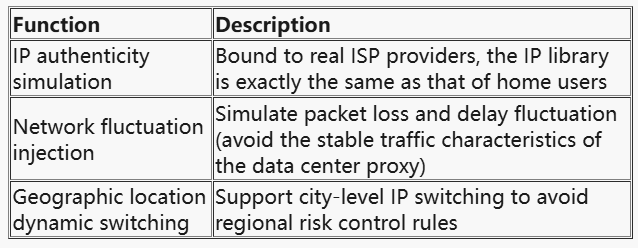Today in 2025, with the growing demand for web crawler technology and data capture, the risk control systems of major websites are also constantly upgrading. Among them, Cloudflare, as an industry-leading security service provider, has a particularly powerful risk control system. In order to effectively fight Cloudflare's 2025 risk control mechanism, dynamic residential proxy combined with JA4 fingerprint disguise technology has become the preferred strategy for many crawler developers. This article will disassemble the implementation principle and application method of this technology in detail.
Overview of Cloudflare 2025 Risk Control Mechanism
Cloudflare's risk control system uses a series of complex algorithms and rules to identify and block potential malicious requests. These requests may include automated crawlers, DDoS attacks, malware propagation, etc. In order to deal with these threats, Cloudflare continues to update its risk control strategies, including but not limited to IP blocking, behavioral analysis, TLS fingerprint detection, etc. Among them, TLS fingerprint detection is one of the important means for Cloudflare to identify abnormal requests.
Technical Positioning of Dynamic Residential Proxy
The value of Dynamic Residential Proxy has been upgraded from "IP anonymity" to full-link environment simulation. Its core capabilities include:
JA4 fingerprint camouflage technology dismantling
1. JA4 fingerprint generation logic
Cloudflare JA4 fingerprint generates a unique identifier by hashing the TLS handshake features. Key parameters include:
- TLS version: TLS 1.3 is mandatory (version 1.2 and below will be eliminated in 2025);
- Cipher suite order: browser default suite priority (such as
TLS_AES_256_GCM_SHA384takes precedence overTLS_CHACHA20_POLY1305_SHA256); - Extended field camouflage:
SNI(Server Name Indication) andALPN(Application Layer Protocol Negotiation) must be exactly the same as the browser. Sample code: Python TLS client configuration
from scapy.layers.tls import *
# Simulate Chrome 120 TLS fingerprint
tls_params = {
"version": "TLS 1.3",
"ciphers": [0x1302, 0x1303, 0x1301], # AES-GCM/SHA384, ChaCha20/SHA256
"extensions": [
TLS_Ext_SupportedGroups(groups=["x25519", "secp256r1"]),
TLS_Ext_KeyShare(),
TLS_Ext_SupportedVersions(versions=["TLS 1.3"])
]
}
2. Collaborative strategy of dynamic proxy and JA4
Step 1: Pre-screening of proxy pools
Use ASN library verification (such as ipinfo.io) to keep only IPs of residential ISPs (such as Comcast, AT&T);
Inject real user network noise (such as random packet loss rate of 0.1%-2%).
Step 2: Dynamic fingerprinting
- Assign an independent TLS profile to each proxy IP (simulating different browsers/device models);
- Use the
ja4xtool to generate fingerprint hashes to ensure that they match the whitelist of the target website.
Step 3: Request link encryption
- Deploy a traffic obfuscation module (such as uTLS-based protocol camouflage) on the proxy server side;
- Encrypt the WebSocket transport layer to bypass man-in-the-middle sniffing (MITM).
Countermeasures and risk assessment
1. Measured data (January-February 2025)
2. Legal and risk control red lines
Compliance: Avoid collecting privacy data protected by GDPR/CCPA (such as user identity and biometric information);
Countermeasures: Cloudflare has introduced JA5 fingerprinting (based on the TCP handshake mechanism), and the camouflage algorithm needs to be updated in real time.
Precautions in practical application
When applying dynamic residential proxy combined with JA4 fingerprint camouflage technology to fight against Cloudflare risk control, the following points should also be noted:
- Proxy quality selection: Select high-quality and stable dynamic residential proxy services to ensure the effectiveness and anonymity of the proxy IP.
- Fingerprint camouflage strategy adjustment: According to the update of the target website and Cloudflare risk control system, timely adjust the JA4 fingerprint camouflage strategy to maintain the effectiveness of the camouflage effect.
- Comply with laws and regulations: During the data crawling process, it is necessary to comply with relevant laws and regulations and the terms of use of the website to avoid infringing on the privacy and rights of others.
- Risk assessment and response: When using this technology, the risks that may be faced should be fully assessed, and corresponding response measures should be formulated to ensure the legality and security of data crawling activities.
Conclusion
Dynamic residential proxy combined with JA4 fingerprint camouflage technology is an effective means to fight Cloudflare 2025 risk control. By hiding the real IP address, simulating real user behavior and TLS fingerprints, we can reduce the risk of being identified by the risk control system and improve the success rate and efficiency of data crawling. However, when implementing this strategy, we also need to pay attention to issues such as the selection of agent quality, the adjustment of fingerprint disguise strategies, and compliance with laws and regulations to ensure the legality and security of data scraping activities.





Top comments (1)
Fascinating deep dive! JA4 fingerprinting is evolving fast, and it’s great to see this kind of analysis on how LNC is approaching evasion. Really appreciate the technical breakdown—definitely food for thought in the ongoing privacy vs. security debate.
@deltarune